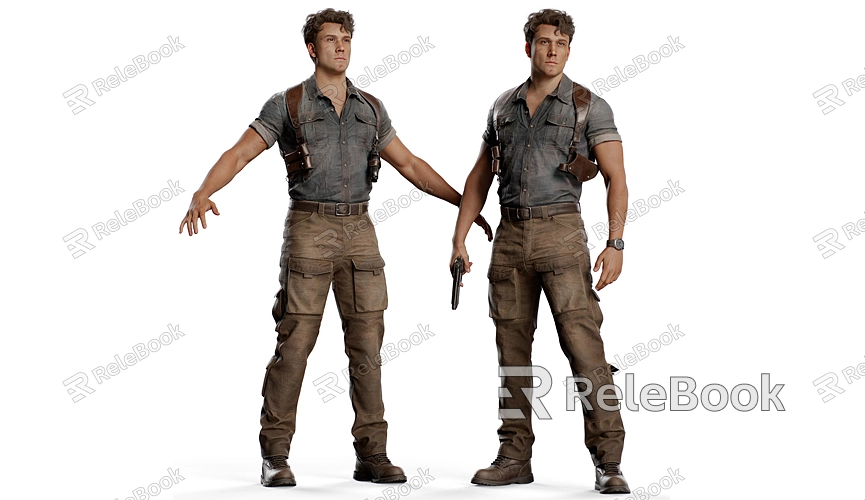How to rip 3d models from games blender
In 3D modeling and game development, extracting and using existing 3D models is a valuable skill. Many game developers and designers seek to extract models from games for use in their own projects or for modification. Blender is a powerful open-source 3D modeling tool that can help you achieve this goal. This guide will walk you through the process of ripping 3D models from games in Blender and offer some practical tips and advice.
Preparation

Before you start, there are a few preparations you need to make:
1. Choose the Right Tools: Extracting 3D models from games often requires additional tools and plugins. Common tools include Unity Asset Studio, Ninja Ripper, and 3D Ripper DX. These tools can help you export models and textures from games.
2. Understand the Game's File Formats: Different games use different file formats to store 3D models. Knowing the file format used by the game you want to extract from will help you choose the right extraction tool and ensure that the exported models can be correctly imported into Blender.
3. Ensure Legality: Extracting and using 3D models from games involves issues of copyright and usage rights. Make sure you have the right to use and modify these models and adhere to relevant laws and regulations.
Extracting 3D Models

1. Use Extraction Tools: Start by using your chosen extraction tool to pull 3D models from the game. For instance, if you’re using Unity Asset Studio, open the tool, select the resource files of the target game, and export the models you need.
2. Process Model Files: Extracted model files often need some processing. Common file formats include FBX, OBJ, and DAE. Depending on the extraction tool, you may need to use a conversion tool to convert these files into a format supported by Blender.
3. Import into Blender: In Blender, go to the “File” menu, select the “Import” option, and choose the appropriate file format (such as FBX or OBJ). Select the extracted model file and click “Import.” Blender will load and display your model.
Configuring the Model
The extracted 3D model may need some configuration and adjustment:
1. Check Model Details: After importing, inspect the model’s details, including the mesh, textures, and materials. Ensure that all parts of the model are correctly imported and make any necessary repairs and adjustments.
2. Adjust Textures and Materials: Sometimes, the extracted model might be missing or have damaged textures and materials. In Blender’s “Materials” panel, you can reapply or adjust materials. Apply the extracted texture files to the model to ensure it appears correctly.
3. Fix UV Mapping: Imported models might require UV mapping adjustments. In Blender’s “UV Editor,” check the UV layout of the model and make necessary adjustments to ensure textures are mapped correctly onto the model’s surface.
4. Optimize the Model: The extracted model may contain unnecessary details or excess polygons. Use Blender’s “Edit Mode” to optimize the model, reducing excess polygons and vertices to improve performance and rendering efficiency.
Rendering and Applying
After configuring the model in Blender, you can proceed to rendering and application:
1. Set Up the Scene: Create a scene in Blender suitable for your model, including background elements, lighting, and camera. Set up appropriate lighting and camera angles to showcase the model at its best.
2. Render the Model: Choose a Blender rendering engine (such as Cycles or Eevee), adjust render settings including resolution and sampling rates, and click the “Render” button. Blender will generate an image of your model.
3. Apply to Projects: You can use the extracted model in your own projects, such as game development or animation. Ensure that you make necessary adjustments and optimizations based on your project requirements.
Practical Applications
Ripping 3D models from games not only helps you learn game development techniques but also provides valuable resources for your projects. For example, you can use the extracted models for game prototyping, animation testing, or creating your own 3D art. With Blender’s powerful modeling and rendering capabilities, you can further modify and optimize these models to achieve better visual results.
The process of extracting 3D models from games in Blender involves using extraction tools, importing and configuring models, and performing rendering and application. Mastering these techniques will help you better utilize existing resources and enhance your 3D creation efficiency. If you need high-quality 3D textures and HDRI for your projects, you can download them for free from [Relebook](https://textures.relebook.com/). For exquisite 3D models, visit [Relebook](https://3dmodels.relebook.com/). Relebook offers a wide range of premium 3D resources that can further elevate your design and rendering quality, making your 3D projects stand out. We hope this guide helps you better understand how to extract and use 3D models from games in Blender.

